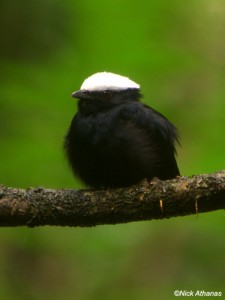More Than Just Snap, Crackle, and Pop

The neotropics are blessed with many families of birds that you can’t see in your neighborhood park up north. But perhaps none of these are more interesting, from an acoustical perspective, than manakins. They defy expectations when it comes to making sounds: some of them rub modified feathers together like a cricket, while others beat at the air, snap their wings against their body, or engage in elaborate, ritualized displays involving multiple birds making a smorgasbord of weird mechanical sounds. And some of them just sit there all day on one perch and say “nicky-the-greek” over and over and over again.
Being suboscines, manakins are thought to not learn their songs , instead having them hard-wired into their DNA. And as with other suboscines, this has important implications for their taxonomy when major differences between populations occur. In at least one manakin clade (White-ruffed and White-bibbed Manakins), differences in vocalizations and displays played a role in considering them separate species.
When it comes to sounds, the White-crowned Manakin (Pipra pipra) isn’t the most interesting of the family. Its displays are mundane compared to those of, say, Long-tailed Manakin. And the mechanical sounds it makes are limited and mostly simple. But it does appear to have a plethora of distinct vocal types that may well correspond to different species, despite the fact that they all look nearly or completely identical to each other in plumage.
A recent trip to the remote Cordillera del Condor in far southeastern Ecuador piqued my interest in this vocal variety when I heard a new vocal type, one I hadn’t even known existed until the day before. That brought the total vocal types that I knew of up to three, each replacing the other in very close proximity in a complex system of allopatry that is unlike any other species group in Ecuador. I was interested to see how many there really were if I listened to recordings from throughout their range. What I found shows that there are more to learn about manakins than just how they make their weird noises (which is what most recent manakin research has focused on)…complex taxonomical puzzles also remain to sweeten the pot. I’ve written a feature on xeno-canto detailing what I’ve found – take a look!